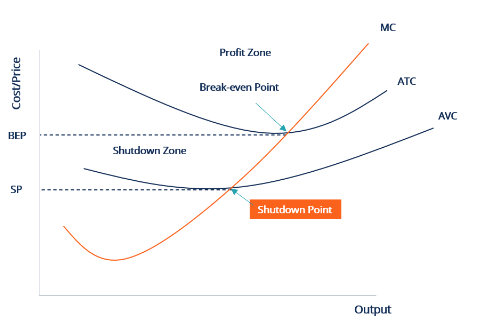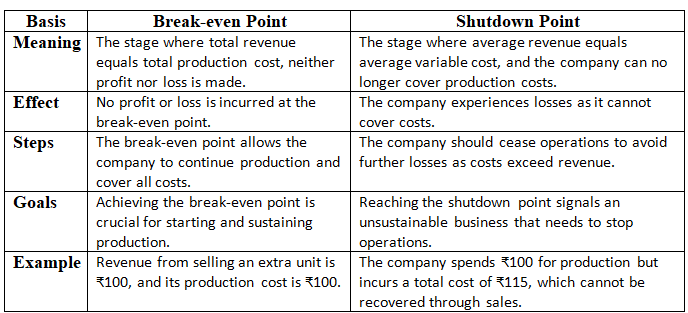Shut Down or Continue Operations | UGC NET Commerce Preparation Course PDF Download
Every business operates with the aim of generating profits, striving to increase revenue and expand market share. However, intense competition makes it challenging to achieve these objectives. To stay competitive, management must make timely and accurate decisions regarding production, marketing, and finances. Despite these efforts, a company may still be outperformed by a larger rival, potentially leading to the decision to shut down operations. The shutdown and break-even points are key aspects of a company's financial considerations. Alternatively, a company may choose to continue its operations, with tax planning playing a critical role in the decision to shut down or keep going, as it impacts the company's financial outlook.
What is the Shutdown Point?

The shutdown point occurs when a company decides to cease its operations, either permanently or temporarily. This decision often arises when the company is operating at a loss or at a break-even point with no profits or losses over an extended period.
In the short run, a company may reach its shutdown point when it's incurring losses or at a break-even level for a prolonged time. If continuing operations no longer offers any benefits, management may opt for a shutdown. In a perfectly competitive market, the shutdown decision is influenced by the market price. If the market price falls below the average variable cost (AVC), the company cannot cover its operational costs and must consider shutting down, as it cannot raise prices due to competition.
- Marginal Cost (MC): The cost of producing one additional unit.
- Average Total Cost (ATC): Total costs divided by the number of units produced.
- Shutdown Price (SP): The price at which a firm can no longer cover its average variable costs.
- Average Variable Cost (AVC): Variable costs divided by the total units produced.
- Break-even Price (BEP): The point where total revenue equals total costs.
Exploring Shutdown Decision in Business
When it comes to the shutdown point, the management faces a critical decision.Shutdown Point- The shutdown point decision involves determining whether to cease operations or continue running the business. This decision can be made in perfect competition for varying durations, based on the company's requirements.
- In some cases, a company might reach a point where its marginal revenue equals the product's marginal cost. This signifies that the cost of producing an additional unit matches the extra revenue generated by that unit.
- At this equilibrium, the company does not yield any profit from increasing production. However, there are scenarios where marginal revenue could be minimal or negative, indicating that the company is operating at a loss.
- In a monopoly setting, it is advisable for the shutdown point to be considered when the company is incurring losses to prevent further financial decline.
- Temporary shutdowns may also be implemented by management in response to external factors causing a short-term increase in production costs. Nonetheless, even during a temporary shutdown in monopolistic competition, fixed costs remain a burden for the company.
Operational Continuity
Operational or business continuity involves the strategies and procedures put in place to ensure the smooth functioning of a business, even during challenging circumstances. This encompasses the ongoing operations of essential business functions. The continuity measures are crucial to sustain business operations in the face of:
- Continued financial losses experienced by the company
- A disaster such as a natural calamity that disrupts normal business operations
- A significant shift in market dynamics and structure
The primary objective of operational continuity is to facilitate a swift return to normal business operations through well-informed decisions made by the management.
Shutdown Point in Marginal Costing
The shutdown point in marginal costing signifies the threshold at which a company's total revenue matches its variable costs, resulting in zero profit.
What is Shutdown in Economics?
In economics, the concept of shutdown pertains to the necessity of deriving economic benefits from operating a business. This typically involves generating increased profits to sustain and expand the company. However, when a business finds itself at a point of equilibrium or facing losses, it may be compelled towards the shutdown point.Shutdown Point
- Illustration: Consider a scenario where a company incurs a marginal cost of ₹100 to produce a unit of their product, and the marginal revenue from selling this unit is also ₹100. In this case, the company merely covers its expenses without making any profit.
- This situation results in no profitability for the company. Consequently, the owner must contemplate whether to continue operations or initiate a shutdown. If the company continues production, it might incur losses per unit of the product. It should only persist if it can reduce production costs or enhance prices without negatively impacting sales.
- The shutdown point serves as a crucial decision-making tool to prevent losses and facilitate an exit from business activities. Decisions regarding shutdown vary among companies based on their analysis of market trends, anticipated changes, and financial status.
Understanding the Shutdown Point of a Firm

The concept of the shutdown point in a firm pertains to a critical juncture where a company faces the decision of whether to halt production or continue operations. This decision is based on various factors related to costs and revenues.
Key Considerations at the Shutdown Point:
- Variable Costs vs. Variable Revenue: At the shutdown point, it is crucial to assess whether the variable costs incurred by the company exceed the revenue generated from the sale of units. If the costs of production surpass the income earned, it indicates an unsustainable business scenario.
- Profit Maximization: The primary objective of any business is profit maximization. However, when the shutdown point is reached, the company may need to deviate from this goal to avoid further financial losses.
- Cost-Benefit Analysis: Before making a decision at the shutdown point, a comprehensive cost-benefit analysis is essential. This analysis should factor in both fixed and variable costs to determine the overall impact on the company's finances.
- Long-Term Viability: While short-term losses may indicate the need to shut down operations, evaluating the potential long-term benefits of continuing business activities is also crucial. This assessment helps in making informed decisions about the company's sustainability.
- Management Decision and Financial Analysis: The responsibility of deciding whether to reach the shutdown point lies with the management. They must carefully analyze the firm's financial status and explore strategies to minimize losses effectively.
 |
Test: Shut Down or Continue Operations
|
Start Test |
How Does The Shutdown Point Work?
Companies often encounter situations where they need to consider a shutdown point for a product line or business unit due to various reasons like seasonal changes or shifts in the market.Shutdown Point
- The shutdown point signifies the moment when a company operates at a loss because its variable revenue matches its variable costs, while fixed expenses persist, resulting in overall losses.
- There are different scenarios for a shutdown point. For instance, consider a company that creates decorative items for occasions. If a certain product, like Christmas decorations, sells well only during the festival season and has no demand afterward, the company may temporarily halt production to prevent losses, resuming when demand picks up.
- Another example involves a permanent shutdown point, such as when technological advancements render certain products obsolete. For instance, companies selling DVD players might face negligible demand due to technological shifts, prompting them to exit the market to prevent continued losses.
Impact of Ignoring the Shutdown Point
If companies ignore the shutdown point and continue production despite incurring losses, they will experience significant financial setbacks. Marginal costs will exceed revenue by a large margin, while fixed costs will persist, jeopardizing the company's financial health.
How to Calculate Shutdown Point?
The shutdown point of a business is a critical threshold where the company must decide whether to continue operations or cease them due to financial losses. This decision is based on ensuring that the revenue generated is sufficient to cover all costs, both fixed and variable.Example Calculation:
Let's consider a hypothetical company, ABC, with the following variables:
- Number of units: 800
- Selling price per unit: ₹20
- Fixed company costs: ₹10,000
- Variable cost per unit: ₹11
The company's revenue is calculated as (800 units * ₹20) = ₹16,000. The total variable costs amount to (800 units * ₹11) = ₹8,800. After deducting variable costs from revenue, the company incurs a loss of ₹2,800.
If the company continues operating, it will sustain a loss of ₹2,800. However, if it shuts down, it will only bear the fixed costs of ₹10,000. The shutdown point is reached when the selling price drops below ₹11 per unit, making it impossible for the company to cover variable production costs.
Types of Shutdown Points
Every business encounters two critical shutdown points in its operations: one in the short run and the other in the long run.
Long-Run Shutdown Point
The long-run shutdown point is pivotal for understanding a company's profitability over an extended period.
- In the long run, fixed costs become variable. This flexibility allows the company to adjust its pricing strategies accordingly.
- If the product price falls below the per-unit cost, the company faces a crucial decision: shut down operations in the long run to prevent ongoing losses.
Short-run Shutdown Point
The short-run shutdown point signifies the possibility of a temporary or permanent halt in operations.
- This point offers the company the option to selectively avoid certain costs through temporary shutdowns.
- Both short-run and long-run shutdown points play integral roles in managing a company's operations effectively.
Reasons of Shut Down Production
Production shutdowns can happen for a variety of reasons, and they can have a significant impact on a company's operations and finances. Here are some common reasons why production may need to be halted:
- Machinery Breakdown: When essential machinery malfunctions or breaks down, it can bring production to a standstill. This could be due to wear and tear, lack of maintenance, or unexpected technical issues.
- Supply Chain Disruptions: If key supplies or materials are delayed or unavailable, production may need to be stopped until the supply chain concerns are resolved. This could be caused by various factors such as natural disasters, transportation problems, or supplier issues.
- Quality Control Issues: When there are significant quality control problems detected in the production process, it may be necessary to pause production to address these issues. Ensuring that products meet quality standards is crucial for the reputation and success of a business.
- Labor Strikes: Work stoppages due to labor strikes or disputes can force a company to shut down production until the issues with the workforce are resolved. This can have serious implications for meeting production deadlines and fulfilling orders.
- Economic Downturn: During periods of economic instability or downturns, companies may choose to halt production to manage costs, adjust to fluctuations in demand, or reevaluate their business strategies. This is done to ensure the long-term sustainability of the business.
This response provides detailed reasons for production shutdowns in a clear and easy-to-understand manner, following the guidelines provided.
Common Reasons for Production Shutdowns- Maintenance and Repairs: Scheduled maintenance and equipment repairs are crucial to ensure machinery and infrastructure operate efficiently and safely.
- Equipment Failure: Unexpected breakdowns can lead to production halts until repairs are completed.
- Quality Control Issues: Production may pause to address quality problems, preventing defective products from reaching customers.
- Safety Concerns: Immediate halts can occur to maintain a safe environment for workers and prevent accidents.
- Inventory Management: Temporary shutdowns may be needed to manage excess inventory or storage space constraints.
- Supply Chain Disruptions: Delays in receiving materials or components can interrupt production.
- Market Demand Fluctuations: Changes in orders can lead to shutdowns to align production with demand.
- Labor Disputes: Strikes or labor shortages can disrupt operations.
- Financial Constraints: Temporary shutdowns may be necessary to reduce costs or reorganize operations.
- Regulatory Compliance: Changes in regulations may prompt shutdowns to ensure compliance.
- Energy Shortages: Production can halt due to energy supply interruptions.
- Natural Disasters: Events like earthquakes or floods can damage facilities, disrupting production.
- Pandemics and Health Crises: Shutdowns may happen to protect employee health during health crises.
- Strategic Decisions: Companies may temporarily halt production to reallocate resources or change strategies.
- Obsolete Technology or Products: Production lines associated with outdated products may be shut down.
- Environmental Concerns: Shutdowns may occur for environmental remediation or compliance reasons.
 |
Download the notes
Shut Down or Continue Operations
|
Download as PDF |
Difference between Break-Even Point and Shutdown Point
Find below the major difference between break even point and shutdown point.

Conclusion
The "shutdown or continue" decision in a tax planning presentation helps businesses assess their product costs and evaluate their financial standing. This allows management to determine profitability and develop more effective budgets and strategies. By identifying cost-cutting opportunities, companies can reduce expenses, avoid operational shutdowns, and enhance profitability.
|
235 docs|166 tests
|
FAQs on Shut Down or Continue Operations - UGC NET Commerce Preparation Course
| 1. What is the shutdown point in a business context? |  |
| 2. How does the shutdown point differ from the break-even point? |  |
| 3. What are the main reasons a firm might decide to shut down production? |  |
| 4. How can a firm calculate its shutdown point? |  |
| 5. What types of shutdown points exist, and how do they influence decision-making? |  |


























